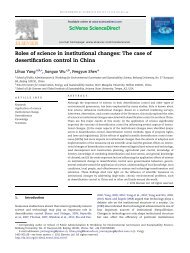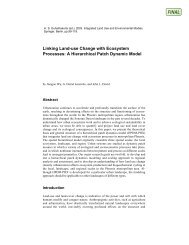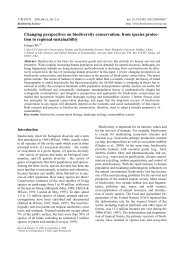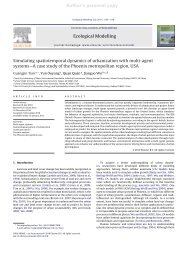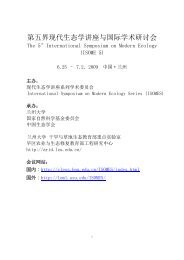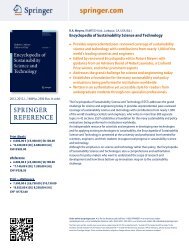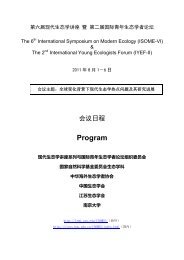Download PDF - Springer
Download PDF - Springer
Download PDF - Springer
You also want an ePaper? Increase the reach of your titles
YUMPU automatically turns print PDFs into web optimized ePapers that Google loves.
228 BERLING-WOLFF AND WU<br />
we desire to detect, γ is the degrees of freedom of the sample standard deviation with b<br />
groups of samples and n samples per group (or γ = b(n − 1)), α is the significance level,<br />
P is the desired probability that a difference will be found to be significant if it is as small<br />
as δ and tα,γ and t2(1−P),γ are values from a two-tailed t-table with γ degrees of freedom<br />
corresponding to probabilities of α and 2(1 − P), respectively. One cannot solve for n<br />
directly because γ is a function of n. Instead, one guesses a value of n, calculates γ , then<br />
solves the equation for n.Ifthe calculated n is not equal to the guessed n,adifferent value<br />
of n is guessed accordingly and the procedure repeats. Here, an estimate of the variability<br />
of selected sampling items (in this case landscape indices) needs to be obtained by running<br />
30 baseline simulations and calculating the sample variance. The minimum number of runs<br />
required to compute the mean of each of the 6 selected metrics is listed in Table 2. At<br />
the landscape level, the minimum number of runs tended to increase with increasing grain<br />
size (i.e., decreasing resolution), but such a trend was absent at the class level (Table 2).<br />
Instead, the finest and coarsest grain sizes required the largest number of runs for deriving<br />
meaningful means of the metrics. To simplify the simulation procedures, we derived the<br />
means of all the metrics based on 30 simulation runs, which was larger than the minimum<br />
number of runs for most landscape metrics (except NP and MPS) at all grain sizes based<br />
on Eq. 3.<br />
Figure 5 shows the results of the six landscape metrics computed for both the whole<br />
landscape including all land use types and the urban class only. The relative differences<br />
between the model and data at each grain size are listed in Table 3. In general, two kinds<br />
of scale effects were apparent: (1) the values of the landscape metrics changed with grain<br />
size (Wu, 2004), and (2) the agreement between the model and the empirical data also<br />
varied with grain size. For a given metric, these scale effects showed similar patterns at<br />
the urban class and the whole landscape levels, but model accuracy measured by these<br />
metrics was consistently higher at the landscape level than the class level (Table 3). Specifically,<br />
the values of the number of patches, edge density, and patch size coefficient of<br />
variation decreased with grain size, and the discrepancy between the model and data measured<br />
by these metrics was greatest at the 60 m grain size, smallest at the 120 m grain<br />
size, and moderate to small for larger grain sizes (figures 5a–d, g–h; Table 3). The average<br />
shape of individual patches (AWMSI) showed a similar pattern without the dramatically<br />
large discrepancy at the finest grain size (figures 5i–j). In contrast, the mean size<br />
of individual patches (MPS) and the shape complexity of the whole landscape (DLFD)<br />
tended to increase with grain size, and so did the model errors represented by these metrics<br />
(figures 5e–f, k–l).<br />
Projecting future urban growth of Phoenix<br />
A major goal of this study was to explore how the Phoenix urban landscape would change<br />
in the future. To achieve this goal, we designed three development scenarios based on<br />
the current political climate and the desires of the residents, and then ran simulations to<br />
examine how these scenarios led to different future development patterns. The sources of<br />
information for developing these scenarios include the Maricopa County Comprehensive




